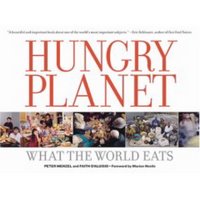Hungry Planet: What the World Eats

 Hungry Planet: What the World Eats by Peter Menzel and Faith D'Aluisio is a fascinating book for anyone interested in food and how other people eat. I sat down to spend five minutes browsing through this book and was completely absorbed for an hour and a half.
Hungry Planet: What the World Eats by Peter Menzel and Faith D'Aluisio is a fascinating book for anyone interested in food and how other people eat. I sat down to spend five minutes browsing through this book and was completely absorbed for an hour and a half. Menzel and D'Aluisio photographed and interviewed 30 families in 24 different countries about what their family eats. Each family is introduced with a family portrait, where family members sit or stand surrounded by a typical week's worth of their food and drink. These portraits are totally amazing and provide an immediate nutritional story for each family.
There's no escaping the pain of the extreme differences between the haves and the have-nots: a German family spends the most on food( $500/wk.), a Sudanese family living in Chad, the least ($1.23 + Food Rations =$24.37). The other painful visual lesson, for me, was how many families graduate economically from eating fresh local foods to eating prepackaged convenience foods. Some families have the most wonderful spread of colorful healthy fruits and vegetables, while others have almost no fresh produce, but rather frozen pizzas, fast food, sugary cereals, and chips . The other detail that got me thinking was the containers of sugary beverages. A nuclear family in Mexico typically drinks a whopping 25 quarts of Coca-Cola per week! I tried to visualize how much juice my kids drink in a week - needless to say, we're cutting back.
Each portrait is followed by a list of all the food the family eats in a week, divided into the following categories: Grains & Starchy Foods; Dairy; Meat, Fish & Eggs; Fruits, Vegetables, & Nuts; Condiments; Snacks & Desserts; Prepared Food; Fast Food; Restaurants; Beverages;Miscellaneous (Vitamins, pet food, cigarettes). Their total weekly expenditure (with US equiv.) is listed, and subtotaled by each of the above categories. These lists are completely fascinating for foodies and non-foodie's alike.
This is followed by a description of family life related to food, cooking, and shopping, a list of common statistics for each country (life expectancy, literacy rate, avg. caloric intake, undernourished population, alcohol consumption, overweight population,number of McDonald's restaurants, cigarette consumption, meat consumption and others) with some country-specific stats thrown in (for example, for the British Family, the number of fish & chip restaurants is listed).
Each family's available cooking methods (ie gas stove, wood fire, microwave etc) and food preservation methods (refrigerator, drying, freezer etc) are specified, along favorite foods and a family recipe. All this is interspersed with colorful photographs of the family eating, cooking, and shopping, as well as local markets, grocery stores, restaurants, and other scenes of family life and local food-related traditions.
In addition to the family stories, there's six essays, each written by a different author, followed by a photo gallery on a related topic. For example Michael Pollan's Food With a Face essay is followed by a Meat themed Photo Gallery. Other topics include cooking methods, fast food, street food, fish and fishing, and diabesity.
I've been showing and recommending this book to all my visitors and watched each of them become completely absorbed. Each person notices something new or has a new question; what will they do with all those eggs? Imagine peeling and cooking 100 lbs of potatoes a week! What is that? But almost everyone asks, "I wonder how my family would look surrounded by a week's worth of our groceries? "
Food for thought.
I highly recommend this fascinating book.
Hungry Planet: How the World Eats by Peter Menzel and Faith D'Aluisio





2 Comments:
Wow! This looks like an interesting read ... I may well try and get hold of a copy!
Thanks for posting
:)
This book was an interesting read, I checked it out a month or so ago. It really shouts out some things wih the big colorful pictures and the real touch your life understandable means of communicating the world food situation.
Post a Comment
<< Home